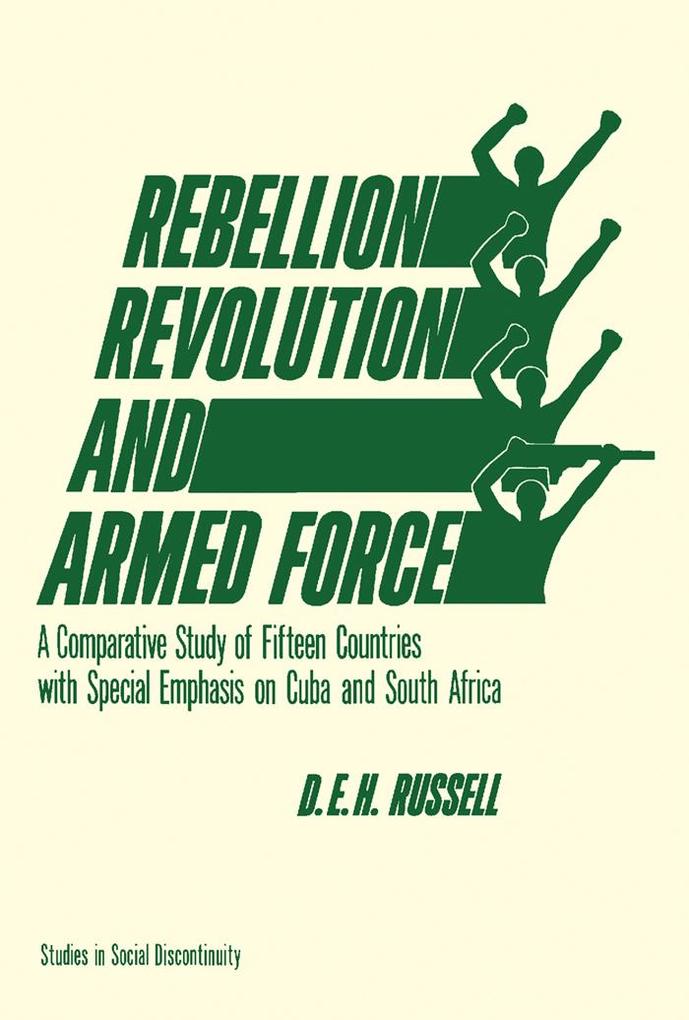
Sofort lieferbar (Download)
Rebellion, Revolution, and Armed Force: A Comparative Study of Fifteen Countries with Special Emphasis on Cuba and South Africa examines the role of armed forces in rebellion. This book raises and discusses the general question relating to oppression.
Organized into eight chapters, this book begins with an overview of relevant literature on rebellion and revolution. This text then discusses the concept of rebellion and considers its relationship to revolution. Other chapters critically evaluate the literature on revolution and rebellion. This book discusses as well the methods used for selecting the seven cases of successful and seven cases of unsuccessful rebellion based on data sources. The final chapter summarizes and examines each of the unsuccessful cases of rebellion in Austria, Cuba, Colombia, Italy, Honduras, Spain, and Burma.
This book is a valuable resource for historians, sociologists, teachers, researchers, and students.
Organized into eight chapters, this book begins with an overview of relevant literature on rebellion and revolution. This text then discusses the concept of rebellion and considers its relationship to revolution. Other chapters critically evaluate the literature on revolution and rebellion. This book discusses as well the methods used for selecting the seven cases of successful and seven cases of unsuccessful rebellion based on data sources. The final chapter summarizes and examines each of the unsuccessful cases of rebellion in Austria, Cuba, Colombia, Italy, Honduras, Spain, and Burma.
This book is a valuable resource for historians, sociologists, teachers, researchers, and students.
Inhaltsverzeichnis
1;Front Cover;1 2;Rebellion, Revolution, and Armed Force: A Comparative Study of Fifteen Countries with Special Emphasis on Cuba and South Africa;4 3;Copyright Page;5 4;Table of Contents;8 5;Dedication;6 6;Preface;12 7;Credits;14 8;Introduction;16 9;Chapter 1. The Ancien Regime, Its Armed Forces, and the Outcome of Rebellion: The Wisdom of the Past;22 10;Chapter 2. Oppression and Rebellion: A Comparison of Cuba and South Africa;31 10.1;Oppressiveness of the Cuban Regime;34 10.2;Regime Unity;37 10.3;Coercion Resources;37 10.4;Summary and Conclusions;41 10.5;Policy of Apartheid;44 10.6;Oppressiveness of the South African Regime;45 10.7;African Reaction to Oppression in South Africa;53 11;Chapter 3. South Africa's Missing Rebellion: A Search for Explanations;57 11.1;Income Distribution and Health;59 11.2;Land Distribution;62 11.3;Occupational Structure;62 11.4;Education;63 11.5;Summary;68 12;Chapter 4. Rebellion and Revolution: Conceputual Clarifications;71 12.1;DEFINITION O F REBELLION AND RATIONALE;71 12.2;TYPOLOGY OF REBELLION;75 12.3;RATIONALE FOR DEFINITION O F MASS REBELLION;77 13;Chapter 5. Method: The Whys and Wherefores of an Empirical Study;85 14;Chapter 6. Analysis, Conclusions, and Implications;92 14.1;IMPLICATIONS OF STUDY;95 14.2;IN SUMMARY;100 15;Chapter 7. Successful Rebellions and the Behavior of the Armed Forces;105 15.1;1. AFGHANISTANTHE SUCCESSFUL REBELLION OF 1929;106 15.2;2. ALBANIA THE SUCCESSFUL REBELLION OF 1924;111 15.3;3. BOLIVIA THE SUCCESSFUL REBELLION OF 1952;115 15.4;4. BRAZIL THE SUCCESSFUL REBELLION OF 1930;118 15.5;5. CHINA THE SUCCESSFUL REBELLION OF 1949;122 15.6;6. CUBA THE SUCCESSFUL REBELLION OF 1959;130 15.7;7. MEXICOTHE SUCCESSFUL REBELLION OF 1911;135 16;Chapter 8. Unsuccessful Rebellions and the Behavior of the Armed Forces;140 16.1;8. AUSTRIATHE UNSUCCESSFUL REBELLION OF 1934;140 16.2;9. BURMATHE UNSUCCESSFUL REBELLION OF 1953;142 16.3;10. COLOMBIATHE UNSUCCESSFUL REBELLION OF 1948;147 16.4;11. CUBATHE UNSUCCESSFUL REBELLION
OF 1912;151 16.5;12. HONDURASTHE UNSUCCESSFUL REBELLION OF 1933;153 16.6;13. ITALYTHE UNSUCCESSFUL REBELLION OF 1914;155 16.7;14. SPAINTHE UNSUCCESSFUL REBELLION OF 1934;157 17;Appendix I. Operationalizing the Definition of Mass Rebellion;160 17.1;DEFINITIONS RESTATED;161 17.2;I. OUTCOMES OF MASS REBELLION;161 17.3;II . VIOLENT POWER STRUGGLES AND "MEANS" THAT INCLUDE VIOLENCE;163 17.4;III. AUTONOMOUS POLITICAL SYSTEMS;163 17.5;IV. OVERTHROW OF THE REGIME IS THREATENED;165 17.6;V. THE PARTICIPANTS ARE LARGELY FROM THE MASSES;165 17.7;CASE-SELECTION RULES;166 18;Appendix II. Diagrams of Case Selection Procedure;167 19;Appendix III. Assessments of Scale of Rebellions Sampled;169 19.1;1. AFGHANISTAN (1929);169 19.2;2. ALBANIA (1924);171 19.3;3. BOLIVIA (1952);173 19.4;4. BRAZIL (1930);174 19.5;5. CHINA (1927-1949);175 19.6;6. CUBA (1953-1959);177 19.7;7. MEXICO (1910-1911);179 19.8;8. AUSTRIA (1934);181 19.9;9. BURMA (1948-1953);183 19.10;10. COLOMBIA (1948);184 19.11;11. CUBA (1912);186 19.12;12. HONDURAS (1933);187 19.13;13. ITALY (1914);189 19.14;14. SPAIN (1934);190 20;Bibliography;192 20.1;GENERAL SOURCES;193 20.2;SOURCES USED FOR OBTAINING A UNIVERSE OF MASS REBELLIONS;209 20.3;CASE STUDY SOURCES AFGHANISTAN;209 20.4;ALBANIA;210 20.5;AUSTRIA;210 20.6;BOLIVIA;211 20.7;BRAZIL;211 20.8;BURMA;212 20.9;CHINA;212 20.10;COLOMBIA;213 20.11;CUBA 1912;214 20.12;CUBA 1958;214 20.13;HONDURAS;215 20.14;ITALY;215 20.15;MEXICO;217 20.16;SPAIN;217 20.17;SOUTH AFRICA;218 21;Index;220
OF 1912;151 16.5;12. HONDURASTHE UNSUCCESSFUL REBELLION OF 1933;153 16.6;13. ITALYTHE UNSUCCESSFUL REBELLION OF 1914;155 16.7;14. SPAINTHE UNSUCCESSFUL REBELLION OF 1934;157 17;Appendix I. Operationalizing the Definition of Mass Rebellion;160 17.1;DEFINITIONS RESTATED;161 17.2;I. OUTCOMES OF MASS REBELLION;161 17.3;II . VIOLENT POWER STRUGGLES AND "MEANS" THAT INCLUDE VIOLENCE;163 17.4;III. AUTONOMOUS POLITICAL SYSTEMS;163 17.5;IV. OVERTHROW OF THE REGIME IS THREATENED;165 17.6;V. THE PARTICIPANTS ARE LARGELY FROM THE MASSES;165 17.7;CASE-SELECTION RULES;166 18;Appendix II. Diagrams of Case Selection Procedure;167 19;Appendix III. Assessments of Scale of Rebellions Sampled;169 19.1;1. AFGHANISTAN (1929);169 19.2;2. ALBANIA (1924);171 19.3;3. BOLIVIA (1952);173 19.4;4. BRAZIL (1930);174 19.5;5. CHINA (1927-1949);175 19.6;6. CUBA (1953-1959);177 19.7;7. MEXICO (1910-1911);179 19.8;8. AUSTRIA (1934);181 19.9;9. BURMA (1948-1953);183 19.10;10. COLOMBIA (1948);184 19.11;11. CUBA (1912);186 19.12;12. HONDURAS (1933);187 19.13;13. ITALY (1914);189 19.14;14. SPAIN (1934);190 20;Bibliography;192 20.1;GENERAL SOURCES;193 20.2;SOURCES USED FOR OBTAINING A UNIVERSE OF MASS REBELLIONS;209 20.3;CASE STUDY SOURCES AFGHANISTAN;209 20.4;ALBANIA;210 20.5;AUSTRIA;210 20.6;BOLIVIA;211 20.7;BRAZIL;211 20.8;BURMA;212 20.9;CHINA;212 20.10;COLOMBIA;213 20.11;CUBA 1912;214 20.12;CUBA 1958;214 20.13;HONDURAS;215 20.14;ITALY;215 20.15;MEXICO;217 20.16;SPAIN;217 20.17;SOUTH AFRICA;218 21;Index;220
Produktdetails
Erscheinungsdatum
03. September 2013
Sprache
englisch
Seitenanzahl
224
Autor/Autorin
D. E. H. Russell
Herausgegeben von
Charles Tilly, Edward Shorter
Verlag/Hersteller
Kopierschutz
mit Wasserzeichen versehen
Produktart
EBOOK
Dateiformat
PDF
ISBN
9781483260952
Entdecken Sie mehr
Bewertungen
0 Bewertungen
Es wurden noch keine Bewertungen abgegeben. Schreiben Sie die erste Bewertung zu "Rebellion, Revolution, and Armed Force" und helfen Sie damit anderen bei der Kaufentscheidung.







